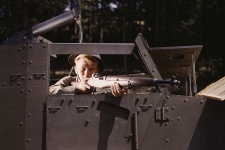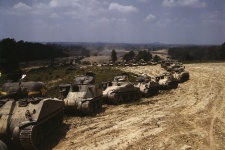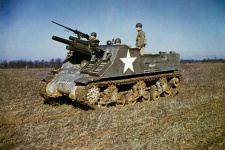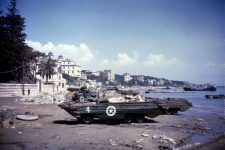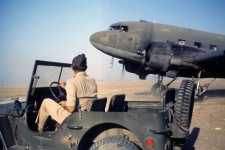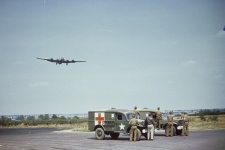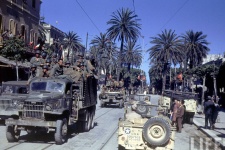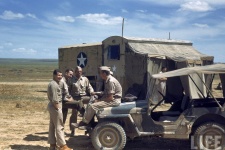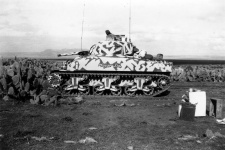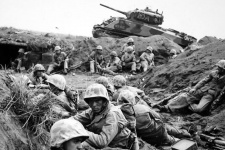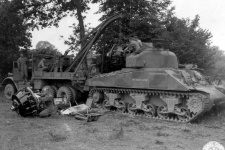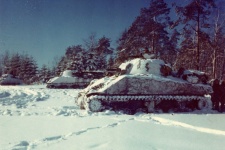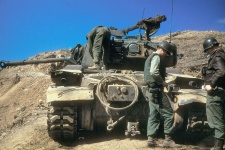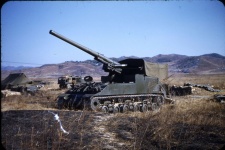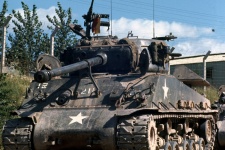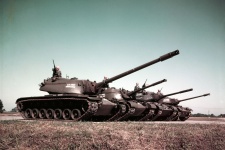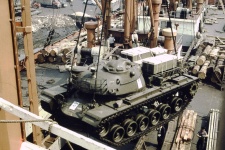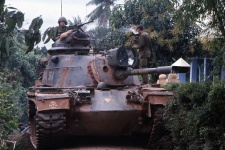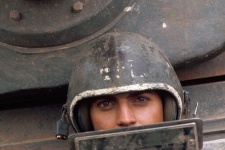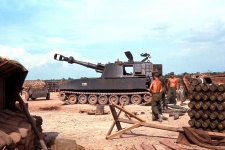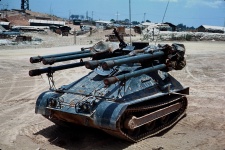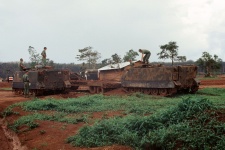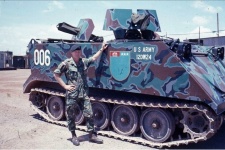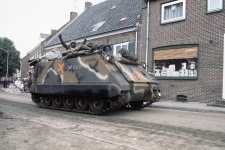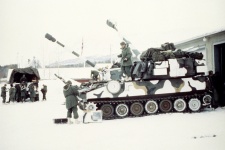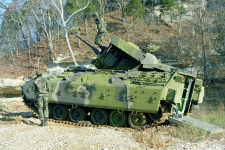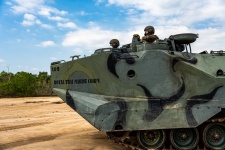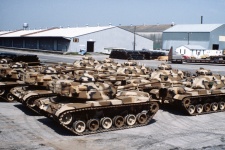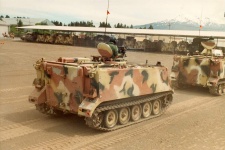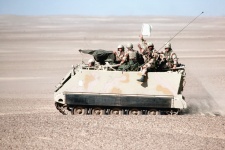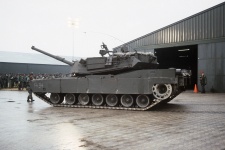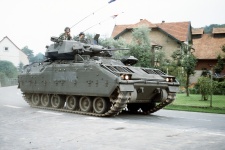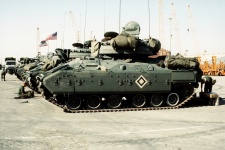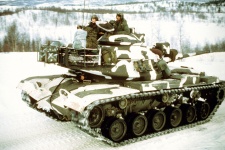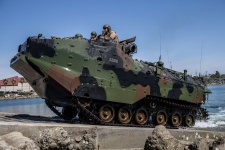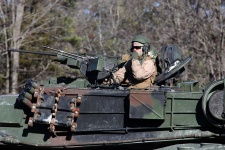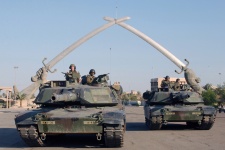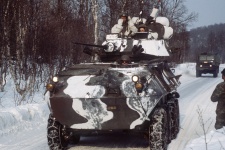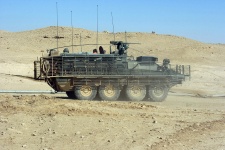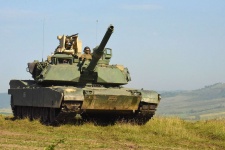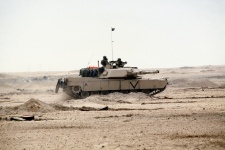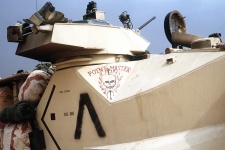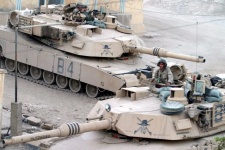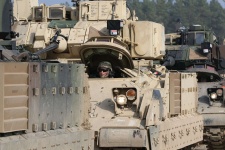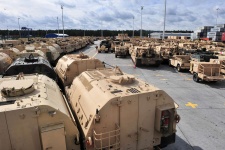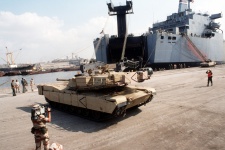AFV Colors and Camouflage, US Army & USMC
![]()
Introduction to US color standards for ground vehicles
The first color standard in use by the US armed forces was known as Specification No. 3-1, introduced on 28 November 1919 and including a palette of 24 colors of which only one would still be in use during World War II. This palette was still in use at the start of World War II although the need to homologize the additional colors being adopted by the different branches of the armed forces resulted in an update with 72 colors known as Specification No. 3-1F on 21 April 1943. This would be the color standard used by the US Army and US Marine Corps for their ground vehicles during the remainder of the war, with the US Air Force and US Navy adopting the Army and Navy Aircraft (ANA) system for aircraft later that year on 28 September 1943.
On 12 January 1950, the US published Federal Specification TT-C-595 which superseded the ANA system with a four-digit numbering system. This was short-lived and on 1 March 1956 was superseded by the Federal Standard system, formally known as FED-STD-595. Each color in the palette is identified by a five-digit code. The first digit refers to the sheen of the paint, these being gloss (1), semi-gloss (2), and matt (3). The second digit refers to the color, these being brown (1), red (2), yellow (3), green (4), blue (5), gray (6), all others including whites, blacks, and metallics (7), and fluorescents (8). The last three digits are unique for each color and typically go from darker to lighter. The initial palette included 358 colors although some colors only officially exist in one or two out of the three sheens. Although the hues are identical regardless of sheen, there have been some notorious exceptions such as a later revision of Olive Drab whose semi-gloss version used by the US Army on tanks (FS 24087) was different from the matt version used on helicopters (FS 34087).
The Federal Standard system has gone through three major revisions, starting with FED-STD-595A on 2 January 1968 (437 colors), FED-STD-595B on 15 December 1989 (611 colors), and FED-STD-595C on 16 January 2008 (650 colors), with numerous additional changes to the palette in between. On 17 February 2017, the Federal Standard system was replaced by the Aerospace Material Specification Standard 595, or AMS-STD-595. It is largely equivalent to the Federal Standard system and most existing colors have been carried over with identical numbers.
Contents:
- World War II (1941-45)
- World War II - Disruptive (1941-45)
- Post-War (1945-60)
- Post-War (1960-75)
- Vietnam War (1964-73)
- MERDC Schemes (1975-84)
- Forest Green (1975-84)
- NATO Scheme (1984-)
- Desert Schemes (1984-)
External Links:
- Federal Specification TT-C-595
- The History of Federal Standard 595
- Federal Standard 595C Range Colour Chart
- AMS Standard 595A Range Colour Chart
- AMS Standard 595 Color
Color guide basics:
All colors in this page include a color guide with matches or equivalences from 19 different model paint ranges. Paints are considered matches if they are labeled with the intended color (either uniquely on together with another color). Paints are considered equivalences if they are close to the intended color but not labeled as such. The accuracy of any paint is independent of whether it is a match or an equivalence and these are described in the text (there can be poor matches and highly accurate equivalences). The following nomenclature is used in the paint tables and is based on matches or equivalences to US Insignia Red FS 11136:
| Paint | Match or equivalence type (label) |
| MP01 | Labeled to match one specific color (FS 11136) |
| MP02* | Labeled to match more than one color of same-country standards (FS 11136 / ANA 509)* |
| MP03** | Labeled to match more than one color of different-country standards (FS 11136 / BS 538) |
| MP04 (!) | Questionable accuracy of label match (doesn't look like FS 11136) |
| MP05 (?) | Questionable accuracy of label match, untested (doesn't look like FS 11136 in the bottle or photos) |
| (MP06) | Known close equivalent to FS 11136 (BS 538) |
| (MP07) (?) | Questionable equivalent to FS 11136 (Generic Gloss Red) |
* A single asterisk also denotes implicit matches for same-country standards where there is an official succession between standards. For example, H327* would match ANA 509 even if the label only references FS 11136 since ANA 509 is its official predecessor. This does not apply when there are considerable differences between successive paints (ex: Olive Drab No. 41/ANA 613/FS 34087) and this will be described in the text. By and large, however, single asterisk matches should be considered close enough to unique matches as to not be seriously questioned.
The paint charts make no distinction between gloss, semi-gloss, and matt variants of a color if the correct sheen is unavailable (ex: gloss FS 11136 will be a specific match for matt FS 31136 if the latter does not exist in the same paint range). Exceptions are made where there is a known or suspected color difference (ex: FS 24087 and 34087).
![]()
World War II
Probably no army in history has had a relationship with a single color as the US Army has had with Olive Drab. This color was originally introduced as early as World War I and became the standard color for all combat vehicles until the second half of the Cold War. Olive Drab is a tricky color to understand, being by nature a darkened yellow (technically it is a Munsell yellow) that depending on lighting and fading can resemble a dark olive green or brown. Just slight changes to the saturation and color balance of a photo can make it look vastly different, which complicates any definitive interpretation of what the 'correct' color actually is which is made worse by the fact that the World War II era shade of Olive Drab is no longer in widespread use and does not have an exact FS match, although FS 33070 is believed to be the closest. Olive Drab was one of th paints specified under Specification 3-1 in the pre-war years where it was produced in lusterless (matt) form known as Olive Drab No. 22. This naturally led to excessive wear even by peacetime standards, which resulted in a reformulation in November 1937 into a more resistant synthetic enamel with a gloss finish; this in turn made it look darker than the matt version even though the paint formulation was the same. This was changed yet again into a matt enamel on October 12th, 1940 which became the standard on wartime vehicles. A parallel designation by the Corps of Engineers (which became responsible for camouflage later in 1940) was known as Olive Drab No. 9 but was otherwise identical to No. 22. It should be noted that official pigment mixes for OD were never provided, therefore paint manufacturers frequently created their own interpretations that varied slightly from each other. This became less of a problem from late 1942 when stricter adherences to official standards were enforced, but wartime photos can be found of vehicles standing next to each other with significant differences in their OD shades.
An attempt to update Specification 3-1 and homogenize camouflage colors across all branches of the military in 1943 resulted in a reformulation of the basic color into Olive Drab No. 319. In theory, No. 319 was identical to No. 9/22 although it is often (incorrectly) described as lighter due to its comparison with the USAAF's Dark Olive Drab No. 41 which it used instead of No. 319 due to its superior infrared camouflage properties. In practice, however, improved quality of the paint meant that No. 319 was less prone to fading and wear and consequently looked darker by virtue of its ability to maintain its original color better than its predecessor. It has been claimed that OD 319 came too late in the war to be used on actual wartime vehicles, however this does not appear to be confirmed by any authoritative source. The origin of this myth may be a confusion with the situation of ANA 613, which replaced OD 41 on USAAF aircraft but which was rarely used on combat aircraft due to the switch to natural metal finishes. There is also a belief that US Army and USAAF versions of Olive Drab were significantly different but this is not necessarily the case except when looking at original color chips and freshly painted equipment: although some photos picturing both aircraft and vehicles show variations in hue and shade, many others don't. If anything, Army OD tends to look darker than the 'Dark' Olive Drab of the USAAF, which may be explained by aircraft spending more time under the sun and therefore fading quicker. As to whether one was greener than the other, this is also trivial, as the variations in hue are well within the realm of what be accounted for by color balance. You will just as easily find a US Army vehicle looking brown or green as you will a USAAF aircraft.
As a final point, it is worth mentioning that photos will never do justice to a color with such different interpretations as is Olive Drab the absence of an actual color chip or a vehicle freshly painted to wartime standards (of which there are none by now). Minor variances to a color balance, saturation, and lightness will make OD look greener or browner and many photos found on the internet have now been far removed from the originals, which themselves may have not captured the correct color balance either. As such, basing an interpretation of the correct color of Olive Drab on photos alone is inappropriate and only serves to perpetuate the myriad of modeling myths that persist, often with little evidence to them. The fortunate conclusion from this is that modelers have considerable leeway in how their Olive Drab can look and should rarely feel they got the color wrong insofar as it resembles an existing photograph of this ubiquitous yet very visually problematic color.
Paint guide:
- Olive Drab No. 9/22: There is widespread confusion and myths regarding what OD 9/22 looked like and consequently, just how much different it should be to the USAAF versions. Tamiya's original XF-62 was often widely regarded as an accurate, if a bit too dark, representation of OD 9/22 which properly captured its olive brown nature. Unfortunately, Tamiya is known to have recently revised its formula leaving a much greener color. Gunze's 'Army' OD, H78/C38, remains a good match (in the Zaloga article cited, he incorrectly compared Gunze's H52/C12 which is their USAAF shade and far too brown). AK Real Colors has a specific OD 9/22 match (RC023) which errs towards brown and also has a Faded Olive Drab counterpart (RC024), though the latter has a bit more of a greenish hue which means manually fading RC023 is probably preferred. Lifecolor has an extensive six-piece set of US Army OD paints (set No. 6) one of which matches FS 33070 and is therefore presumably their OD 9/22 variant. Vallejo's 71.347 is labeled Russian AF Dark Green but is matched to FS 33070 and looks the part.
- Olive Drab No. 319: For all intents and purposes, OD 319 should be identical to OD 9/22. Colourcoats, Lifecolor and Mission Models are the only ones to make specific OD 319 paints (Colourcoats labels it simply as '1943 Olive Drab') although, confusingly, the latter two also have versions of FS 33070 which seem to be darker and greener than their No. 319 versions. Personally, I would go with their FS 33070 paints as there is no evidence to suggest OD 319 was lighter.
Links:
- Olive Drab (Steven Zaloga)
- Shades of Olive Drab (Paul Lucas)
| No. 9/22 | No. 319 | |
| Olive Drab | Olive Drab | |
| Schemes | ||
| Early | Overall | |
| Late | Overall | |
| Color matches | ||
| Gunze Aqueous | H78 | - |
| Gunze Mr. Color | C38 | - |
| Humbrol | 155 | - |
| Model Master | - | - |
| Revell | - | - |
| Tamiya | (XF-62) | - |
| Vallejo Model Air | 71.347** | - |
| Vallejo Model Color | - | - |
| AKAN | (62060) (?) | - |
| AK Interactive | AK 4211 | - |
| AK Real Colors | RC023 | - |
| AMMO by Mig | A.MIG-926 | - |
| Colourcoats | - | ARUS03 |
| Hataka | - | - |
| Lifecolor | UA 219* | UA 220 |
| Mission Models | MMP-026* | MMP-024 |
| Mr. Paint | - | - |
| Xtracolor | - | - |
| Xtracrylix | - | - |
World War II - Disruptive
Soon after the US entered World War II it became clear that a single color for tanks and AFVs would not be adequate in all environments given the differences in climate, topography, and foliage. Work therefore began on a series of disruptive camouflage schemes, the first of which was FM 5-21 from October 7th, 1942 which proposed separate temperate, desert, and arctic schemes. None of these were applied extensively and instead, many vehicles in North Africa applied ad hoc disruptive patterns using whatever resources were at hand such as dried mud, or borrowed British Army paints which had a more extensive range of sand and earth hues. An early version of disruptive camouflage applied extensively was the use of Earth Yellow No. 6 over the base Olive Drab No. 9/22 on vehicles involved in Operation Husky, the invasion of Sicily. Standardized rules for disruptive camouflage would finally appear in FM 5-20B Camouflage of Vehicles, published in April 1944. This included three main camo patterns temperate/jungle, desert, and snow terrains. The temperate/jungle pattern was widely used in Northwest Europe from the Normandy campaign onward and was composed of an Olive Drab base, Black No. 10 disruptive camo, and a White No. 11 undersurface countershade the latter which was rarely applied in practice. The desert pattern consisted of an Olive Drab base and, either Earth Red No. 8 for reddish desert backgrounds, or Sand No. 3 or Earth Yellow No. 6 for other desert terrains. Finally, the snow pattern consisted of Olive Drab and White, although it also specified Black and White which was not widely used (if at all). Whereas the temperate/jungle and desert patterns followed neat disruptive lines, the snow pattern was not applied consistently, with some vehicles painted almost entirely white while others having very crude patterns that were clearly applied in an ad hoc manner in the field. As with many militaries, the use of washable white paint/distemper was preferred as it could be removed easily once the snow had melted. This meant that vehicles painted in the snow terrain pattern had much more extensive chipping and wear. It is also the case that ad hoc patterns remained in use throughout the war using any color that was available to units in the field. An additional color worth mentioning is Light Green No. 1. Although not specified in the FM 5-21 or 5-20B guidelines, it was known to have been occasionally used in an ad hoc manner in temperate/jungle pattern vehicles, either as a two-color or three-color camouflage combined with Black.
Although the color guide gives the numbers in their original early war versions, note that these later changed with the update to Specification 3-1 in 1943. These were redesignated as follows: Sand No. 306 (formerly No. 3), Earth Yellow No. 305 (formerly No. 6), Earth Red No. 312 (formerly No. 8), and Light Green No. 321 (formerly No. 1). These colors were likely very similar although Sand No. 306 is said to have taken a more pinkish hue closer to FS 33448 rather than FS 30277 as No. 3 is commonly matched to. Given the absence of desert combat in 1944-45, it is likely that the post-1943 desert colors were never used in action.
Paint guide:
- Light Green No. 1. This is same color as ANA 611/FS 34151, better known as Interior Green and used on USAAF cockpits. As such, there is no shortage of matches across almost every paint range.
- Sand No. 3: This is commonly matched to FS 30277 although the shade will have differed post-war. It is relatively well represented in its post-war version, though notably absent by Gunze. A possible Tamiya approximation is XF-57 Buff, ideally slightly mixed with gray.
- Earth Yellow No. 6: This is commonly matched to FS 30257 although the shade will have differed post-war. It is relatively well represented in its post-war version, though notably absent by Gunze and with only AK Real Colors labeling it as No. 6. Earth Yellow is often labeled Desert Yellow and is available from Humbrol, Tamiya, and AMMO by Mig although none of them reference FS 30257 and thus the caveat that they might not be as accurate.
- Earth Red No. 8: This is commonly matched to FS 30117 although the shade will have differed post-war. It is relatively well represented in its post-war version, though notably absent by Gunze and with only AK Real Colors labeling it as No. 8. A possible Tamiya approximation is XF-52 Flat Earth, which despite commonly seen as an equivalent to RAF Dark Earth, is too red and therefore possibly more appropriate for an Earth Red.
- Black No. 10: Any match to black (ANA 604/FS 37038) will do. Note that in the field black disruptive paint looked very faded on US Army vehicles so the use of a grayish black such as a tire black or NATO black (FS 37030) might be a more suitable alternative.
- White No. 11: Any match to Insignia White (ANA 601/FS 37875) will do. The widespread use of washable paint means this should be applied very irregularly and with significant fading and wear.
| No. 9/22 | No. 1 | No. 3 | No. 6 | No.8 | No. 10 | No. 11 | |
| Olive Drab | Light Green | Sand | Earth Yellow | Earth Red | Black | White | |
| Schemes | |||||||
| Sicily '43 | Base | Camo | |||||
| Temperate/Jungle '44 | Base | Camo (alt) | Camo | Under | |||
| Desert '44 (1) | Base | Camo (alt) | Camo (alt) | ||||
| Desert '44 (2) | Base | Camo | |||||
| Snow '44 | Base | Camo | |||||
| Color matches | |||||||
| Gunze Aqueous | H78 | H58 | - | - | - | (H2) | (H316) |
| Gunze Mr. Color | C38 | C27 | - | - | - | (C2) | (C316) |
| Humbrol | 66 | 226 | - | (93) (?) | (186) | (21) | (22) |
| Model Master | (1711) (?) | 1715* | (1704) | - | (1701) | (1747) | (1745) |
| Revell | - | - | - | - | - | (08) | (04) |
| Tamiya | (XF-62) | - | (XF-57) (?) | (XF-59) (?) | (XF-52) (?) | (X-1) | (X-2) |
| Vallejo Model Air | (71.043) (?) | 71.137* | (71.138) | (71.291) | (71.293) | (71.057) | (71.279) |
| Vallejo Model Color | - | 70.850* | (70.988) | (70.977) | - | (70.861) | (70.820) |
| AKAN | (62060) (?) | 72004* | - | (62044) | - | (78005) | (73146) |
| AK Interactive | AK 4211 | AK 2303 | (AK 4233) | (AK 4222) | (AK 4223) | (AK 719) | (AK 2052) |
| AK Real Colors | RC023 | RC028* | (RC084) | RC030* | RC031* | (RC001) | (RC222) |
| AMMO by Mig | A.MIG-926 | A.MIG-220* | - | (A.MIG-138) (?) | - | (A.MIG-032) | (A.MIG-047) |
| Colourcoats | - | ACUS09 | (ARUS06) | (ARUS09) | - | (ACUS37) | |
| Hataka | - | HTK-_211* | (HTK-_210) | (HTK-_212) | (HTK-_213) | (HTK-_041) | (HTK-_043) |
| Lifecolor | UA 219* | UA 004* | (UA 019) | (UA 305) | (UA 306) | (LC 01) | (LC 51) |
| Mission Models | MMP-026* | MMP-059* | (MMP-131) | (MMP-129) | (MMP-130) | (MMP-047) | (MMP-104) |
| Mr. Paint | (MRP-234) (?) | MRP-131 | (MRP-395) | (MRP-368) | (MRP-387) | (MRP-137) | (MRP-135) |
| Xtracolor | - | X117* | - | - | - | (X012) | (X141) |
| Xtracrylix | - | XA1117* | - | - | - | (XA1012) | (XA1141) |
Post-war (1945-1960)
The main change in the immediate post-war period was the publication of US Army Regulation 850-15 on 1 August 1945 which introduced a new semi-gloss Olive Drab No. 202 (formulated identically to No. 319) which became the new base color of combat vehicles. This was followed by the introduction of the four-digit TT-C-595 standard in 1950 which resulted in semi-gloss Olive Drab 2430 and matt Olive Drab 3412, the latter being the direct successor to No. 319. This standard was short-lived, being replaced by the definitive five-digit Federal Standard system FED-STD-595A on 1 March 1956 which resulted in the semi-gloss Olive Drab FS 24087 for combat vehicles and matt FS 34087 for helicopters (plus a gloss FS 14087 used on administrative vehicles). Although paint formulations changed which may have impacted their effects upon fading, these versions continued to match their wartime versions with the main difference being the darker shade resulting from the semi-gloss finish. In the field this would have mattered little, as gloss and semi-gloss paint tends to turn matt with sufficient wear which would have happened very quickly under combat conditions. Also, the caveat of Olive Drab looking greener in many photos must again be emphasized is due to even minor changes in color balance and lighting.
Paint guide:
- Olive Drab FS 24087 (1): This is the 1956 version of Olive Drab which in theory should be similar if not identical to OD 9/22/319 with the main difference that it looked darker due to the semi-gloss finish. Vallejo's 71.043 is noticeably brown and might be the best suitable for this particular variant of OD, as is Gunze's H52/C18 which is too brown for the USAAF aircraft they are labeled for. By and large, modelers can get away with using OD 9/22/319 for 1950s and early 1960s vehicles albeit with less fading than on a wartime vehicle and possibly slightly darker to account for the semi-gloss sheen.
Links:
- Research on paint colors done by Paul Viens (TM Ordnance Products)
| FS 24087 (1) | |
| Olive Drab | |
| Schemes | |
| Basic | Overall |
| Color matches | |
| Gunze Aqueous | H52 (?) |
| Gunze Mr. Color | C18 (?) |
| Humbrol | |
| Model Master | |
| Revell | |
| Tamiya | |
| Vallejo Model Air | 71.043 |
| Vallejo Model Color | - |
| AKAN | - |
| AK Interactive | - |
| AK Real Colors | - |
| AMMO by Mig | - |
| Colourcoats | - |
| Hataka | - |
| Lifecolor | - |
| Mission Models | - |
| Mr. Paint | - |
| Xtracolor | - |
| Xtracrylix | - |
Post-war (1960-1975)
Continuity of the wartime version of Olive Drab was broken with the introduction of Addendum 2 to FED-STD-595A on 9 May 1960. This replaced the three finishes of Olive Drab with new temporary versions designated X-14087, X-24087, and X-34087. Some sources suggests that these were noticeably darker and greener while others refer to them as lighter and yellower; this author leans towards the former interpretation as nearly every photo during this period shows a deep greenish hue. Further confusion arises from two subsequent changes to the standard. The first came on 2 January 1968 with the introduction of FED-STD-595A. This famously changed the shade of FS 34087 to a lighter version which was optimized for use on helicopters, but left the gloss and semi-gloss versions unchanged. Later on 28 April 1972, Change 3 reintegrated the X- series of 1960 into the standard palette. This should, in theory, not have affected the colors of tactical vehicles which remained based on the semi-gloss FS 24087/X-24087. The fact that the matt version of Olive Drab was now a different shade (which to top it off was represented as significantly lighter in a 1979 revision due to a clerical error) led to the redesignation of all three colors in Change 7 of 1 January 1984, the gloss and semi-gloss versions becoming FS 14084 and FS 24084 respectively while the matt version became FS 34088. By this time, however, Olive Drab had largely been abandoned as a base color for combat vehicles. FS 34087 is provided in the color guide below although it should be clear that it was never used as a main AFV color and, at best, perhaps used very sparingly as a substitute color in the MERDC schemes described below.
An unfortunate consequence for modelers is that FS 34087 is often taken as a catch-all color for post-war Olive Drab. This fails to take into account the changes to the color introduced after 1968, or whether it refers to the original color or the revised X-2/34087. Older paint ranges like Model Master and Gunze tend to represent the lighter post-1968 version, likely with helicopters rather than tanks in mind. As a result, modelers are advised to exercise considerable caution on post-war Olive Drab. It is safe to assume that most vehicles throughout the 1950s still used a version of Olive Drab descended from its wartime variants, and this is evident from the browner shades seen in color photos of the period. From the 1960s onward, a darker and greener version of Olive Drab is advised. Overall, modelers should guide themselves by the hue of the paint rather than the FS color it claims to match; wartime Olive Drabs that err on the side of green may actually be more suitable for X-24087 even if labeled otherwise.
As the next section will describe in greater detail, there is some controversy over whether contemporary US Army and USMC vehicles used a different color than FS X-24087 in Vietnam. Unfortunately, there is a dearth of color photos from US- or Germany-based vehicles during this period from digital archives like the National Archives. As such, the reader is recommended to visit the very extensive galleries of USARMYGERMANY.com (which I have not used here due to watermarking and possible copyright) or consult publications such as Tankograd's REFORGER series (among others) which have plenty of color photos to compare with those from Vietnam, which are much more common online. Another good source of information and discussion on Olive Drab during this period comes from the vintage military vehicle community and it is also recommended to trawl relevant forums for very useful information (some links provided below).
Paint guide:
- Olive Drab FS 24087 (2): This is the X-24087 version of post-war Olive Drab and should be the correct color for the majority of US Army vehicles from the early 1960s until the mid-1970s. Few manufacturers make a specific semi-gloss version of this color, notable exceptions being AMMO by MiG (A.MIG-081) which is a very good match and captures the dark green of this version very well. However, many representations of FS 34087 are actually de facto matches given that semi-gloss paints are not particularly common in modeling ranges. Pre-1968 this is not a problem since both FS 24087 and 34087 are identical. AK Real Colors RC026 and Mr Paint's MRP-234 both look the part, capturing the greenish hue well. The more recent reformulation of Tamiya XF-62, no longer accurate for a wartime shade on account of being too green, may now be more suitable for this post-war version as is JGSDF Olive Drab XF-74 which may be even better.
- Olive Drab FS 34087 (2): To my knowledge, no paint company specifies a post-1968 version of FS 34087 which lends to confusion over which version of this color is being represented. Gunze's H304/C304 is a very good match, capturing the lighter and browner shade perfectly. Model Master 1711 is also a good choice as it is lighter than the pre-1968 color, although it is more olive than brown. Confusingly, Lifecolor produces two versions of FS 34088, the post-1984 rebranded version of this color, with UA 221 (labeled Khaki Drab) looking browner than UA 222. However, they seem to be oriented towards modulation of wartime OD rather than independent base colors themselves. Since FS 34087 was not actually used on combat vehicles, none of these paints are actually suitable except for helicopters. Matches to FS 34088 are taken as equivalents in the color guides.
Links:
- The Skinny on 24087 (Steel Soldiers)
- Olive Drab and FS595B (G503)
| FS 24087 (2) | FS 34087 (2) | |
| Olive Drab | Olive Drab | |
| Schemes | ||
| Vehicles | Overall | |
| Helicopters | Overall | |
| Color matches | ||
| Gunze Aqueous | - | H304 |
| Gunze Mr. Color | - | C304 |
| Humbrol | 155 | - |
| Model Master | - | 1711 |
| Revell | - | - |
| Tamiya | XF-62 (?) | - |
| Vallejo Model Air | 71.043 (!) | 71.016* |
| Vallejo Model Color | - | 70.887* |
| AKAN | - | 62049 |
| AK Interactive | - | - |
| AK Real Colors | RC026 | - |
| AMMO by Mig | A.MIG-081 | - |
| Colourcoats | - | - |
| Hataka | - | - |
| Lifecolor | - | UA 222 (!) |
| Mission Models | - | MMP-025 |
| Mr. Paint | MRP-234 | - |
| Xtracolor | - | - |
| Xtracrylix | - | - |
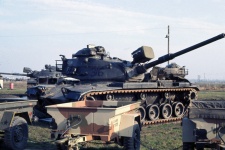 |
A pair of M60A1s of the 64th Armor Regiment in 1974, likely in its base at Schweinfurt, Germany. By this time, X-24087 (now redesignated as 24087) was the official version of Olive Drab used on US AFVs. (Source: Flickr) |
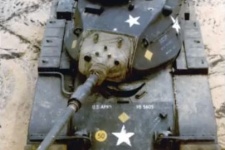 |
An M60E1 prototype from above, showing the deep greenish hue of X-24087 in 1973. |
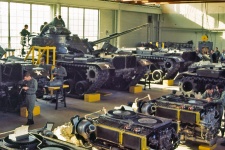 |
A US Army maintenance shop in 1972 showing M48 tanks and their engines getting serviced. Note how the light hitting the turret-less tank in the background make it look greener than the more olive green shade of the other tanks. |
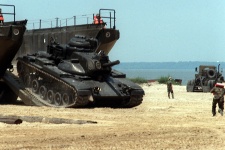 |
An M60A2 rolls out of a landing craft in 1980 but still painted in X-24087, looking particularly dark. |
Vietnam War (1964-1973)
As if the lineage of post-war Olive Drab wasn't complicated enough, there is also the question of whether US Army combat vehicles were painted in different colors during the Vietnam War. There are accounts, unverified by this author, that certain vehicles including tanks may have been repainted with a greener color, possibly Green FS 24064, before shipping to theater. From a tactical perspective, this would make sense as a deeper green would be more suitable to the lush foliage of Southeast Asia compared to olive green or brown shades. It is also believed that USMC tanks were painted in an even greener color, possibly Marine Green #23 FS 24052. Despite this, photographic evidence is far for conclusive given that comparisons with contemporary US- and Europe-based vehicles do not show significant differences that cannot be accounted for by variations in a photo's color balance. It is also not the case that FS 24064 or FS 24052 are significantly greener than X-24087; in fact, they are so remarkably similar it begs the question why the additional time and expense was made for thousands of vehicles to be repainted with colors that do not confer a significant camouflage advantage. As such, the idea that Vietnam-based vehicles were painted in a greener color may well be yet another modeling myth, one that does not appear to have supporting evidence from authoritative sources and may be derived from the fact that USMC helicopters in Vietnam indeed used noticeably greener colors than their US Army counterparts. As such, the paint guide below is merely speculative and readers are advised to compare with the photos in the previous section and make their own minds whether Vietnam vehicles were painted in a different color or not.
Many Vietnam-based vehicles, like their World War II predecessors, were painted in an ad hoc manner in various disruptive patterns, none of which were ever standardized. These appear to use post-war versions of similar colors used in World War II disruptive schemes, such as Earth Red FS 30117, Sand FS 30277, and Black FS 37038 (described in the MERDC section below). The famously reddish soil found in certain regions of Vietnam may have also been used in extreme circumstances as dry mud camouflage, as it looks remarkably similar to Earth Red. The prevalence of ad hoc camouflage further suggests that if indeed some vehicles were painted in a different base color than Olive Drab, this was likely done on a limited basis and possibly with specific missions in mind something which appears to be confirmed in comments in modeling forums by ex-servicemen.
Paint guide:
- Green FS 24064: Very poorly represented with only AKAN, AK Real Colors, and Lifecolor carrying it.
- Marine Green FS 24052: Not the best represented paint, although Model Master among the major ranges carries it. Annoyingly, Vallejo's 70.979 was formerly labeled as FS 34064 and later changed to FS 34052 which goes to show how minimal the differences between the two colors is.
Links:
- What Color For a Vietnam-era USMC M48A3? [Armorama] * Note: numerous factual inaccuracies in the second post, refer to Whiskey6's posts further down *
| FS 24064 | FS 24052 | |
| Green | Marine Green #23 | |
| Schemes | ||
| US Army | Overall | |
| US Marine Corps | Overall | |
| Color matches | ||
| Gunze Aqueous | - | - |
| Gunze Mr. Color | - | - |
| Humbrol | - | - |
| Model Master | - | 2025 |
| Revell | - | - |
| Tamiya | - | - |
| Vallejo Model Air | - | 71.013* |
| Vallejo Model Color | - | 70.979* |
| AKAN | 82046 | 82015 |
| AK Interactive | - | - |
| AK Real Colors | RC342 | - |
| AMMO by Mig | - | - |
| Colourcoats | - | - |
| Hataka | - | - |
| Lifecolor | UA 119 | UA 111 |
| Mission Models | - | - |
| Mr. Paint | - | - |
| Xtracolor | - | X109 |
| Xtracrylix | - | - |
MERDC Schemes
During the early 1970, work on standardizing the myriad of ad hoc camouflage patterns began under the auspices of the US Mobility Equipment Research & Design Command (MERDC). The new schemes were formally specified in December 1975 (TB 43-0147) and were commonly referred to as MERDC camouflage in reference to their developers. The MERDC scheme consists of eight camouflage patterns adapted to different environments all of which shared the common feature of having to main colors each of which covered 45% of the surface area of a vehicle, as well as two contrast colors that covered 5% each. These were based on similar earthly hues as have been traditionally used in disruptive schemes since World War II. These included three greens: Forest Green FS 34079, Dark Green FS 34102, and Light Green FS 34151; four browns: Earth Red FS 30117, Field Drab FS 30118, Earth Yellow FS 30257, and Sand FS 30277; as well as Black FS 37038 and White FS 37875. The different schemes were adapted to a verdant winter (the de facto standard for US and Europe-based vehicles), summer and tropical verdants, two desert schemes (one for gray another for red desert), as well as two snow schemes (one for wood an shrubland the other for open terrain). Another winter arctic scheme was also specified which consisted of overall white and was the only one which did not have any disruptive pattern. There was some leeway in terms of the third color (the earthly contrast color), which was specified to match as close as possible the color of the soil but could be changed if there was a more suitable color in that particular environment.
| 45% | 45% | 5%* | 5% | |
| Winter, verdant | ||||
| FG FS 34079 |
FD FS 30118 |
S FS 30277 |
BL FS 37038 |
|
| Snow, trees & shrubs | ||||
| FG FS 34079 |
W FS 37825 |
S FS 30277 |
BL FS 37038 |
|
| Snow, open terrain | ||||
| W FS 37825 |
FD FS 30118 |
S FS 30277 |
BL FS 37038 |
|
| Summer, verdant | ||||
| FG FS 34079 |
LG FS 34151 |
S FS 30277 |
BL FS 37038 |
|
| Tropics, verdant | ||||
| FG FS 34079 |
DG FS 34102 |
LG FS 34151 |
BL FS 37038 |
|
| Desert, gray | ||||
| S FS 30277 |
FD FS 30118 |
EY FS 30257 |
BL FS 37038 |
|
| Desert, red | ||||
| ER FS 30117 |
EY FS 30257 |
S FS 30277 |
BL FS 37038 |
|
| Winter Arctic | ||||
| W FS 37825 |
W FS 37825 |
W FS 37825 |
W FS 37825 |
* could be changed to a more suitable earthly color.
Many US Army and USMC vehicles began the switch to MERDC during the second half of the 1970s until the establishment of the NATO three-color scheme in 1984. Nevertheless it has been customary to not repaint vehicles unless needed which meant that many MERDC scheme vehicles were still seen well into the 1980s and early 1990s. In fact, there are anecdotal claims of vehicles still in MERDC camo as late as the 2003 Iraq War although, if such is the case, they were probably support vehicles where there was little urgency to repaint them in more modern schemes. By and large, however, new vehicles were no longer painted in MERDC after 1984, and even before this it became increasingly frequent to leave vehicles in their factory finish of overall FS 34079, a scheme described below. That said, the longevity of MERDC is seen in the fact that numerous countries copied one or more schemes and in many cases continue to use them to this day.
Paint Guide:
- Forest Green FS 34079: This is one of the most widely available paints given that it is also a USAF color. Accordingly, almost every major paint range having some version of it. Tamiya unsurprisingly doesn't, although its more woodland-like interpretation of XF-81 (RAF Dark Green) appears to make it a suitable alternative.
- Field Drab FS 30118: This is well represented among the newer paint ranges, less so among the traditional ones. However, FS 30118 and its wartime descendant ANA 617 has long been a substitute for RAF Dark Earth which is almost universally covered by paint manufacturers. Matches to RAF Dark Earth are provided in parenthesis where there isn't a direct FS 30118 match available. One particular oddity is Lifecolor which offers two separate colors (UA 016 and 092) labeled FS 30118 and it is unclear to me which is more accurate. This is separate to Lifecolor's annoying practice of renumbering paints in sets.
- Sand FS 30277: Like most of the MERDC colors, this is well represented among the newer paint ranges but is only available from Model Master (1704) among the traditional ranges. Tamiya's XF-78 (Wood Deck Brown) appears to be a close approximation.
- Light Green FS 34141: Although called Light Green by the US Army, this is better known as the Interior Green used on wartime USAAF cockpits. As such, there is no shortage of matches across almost every paint range.
- Dark Green FS 34102: As with Light Green, this is a color that is also used on USAF schemes and is therefore widely available, although there is not a close Tamiya match (mixing XF-61 and XF-65 might come close). Although Lifecolor offers a FS 34102 match, it should be noted that the dark green (UA 303) included in its NATO MERDC set matches FS 34094 which is clearly a confusion with the green used in the later NATO scheme.
- Earth Yellow FS 30257: This is well represented among the newer paint ranges, less so among the traditional ones and is strangely the only MERDC color not offered by Model Master. Tamiya XF-59 (Desert Yellow) is an acceptable alternative.
- Earth Red FS 30117: This is the least well represented of all the MERDC paints although thankfully available for Model Master (1701). Any red brown (such as German RAL 8017 used on wartime vehicles) is a decent match, however. Tamiya's original XF-64 (Red Brown) formulation would also be close though its recent switch to a less reddish brown might not make it as suitable anymore.
- Black FS 37038: Any matt black will do.
- White FS 37875: Any matt white will do.
| FS 34079 | FS 30118 | FS 30277 | FS 34151 | FS 34102 | FS 30257 | FS 30117 | FS 37038 | FS 37875 | |
| Forest Green | Field Drab | Sand | Light Green | Dark Green | Earth Yellow | Earth Red | Black | White | |
| Schemes | |||||||||
| Winter, verdant | Camo | Camo | Camo | Camo | |||||
| Snow, trees & shrubs | Camo | Camo | Camo | Camo | |||||
| Snow, open terrain | Camo | Camo | Camo | Camo | |||||
| Summer, verdant | Camo | Camo | Camo | Camo | |||||
| Tropics, verdant | Camo | Camo | Camo | Camo | |||||
| Desert, gray | Camo | Camo | Camo | Camo | |||||
| Desert, red | Camo | Camo | Camo | Camo | |||||
| Winter Arctic | Base | ||||||||
| Color matches | |||||||||
| Gunze Aqueous | H309 | (H72) | - | H58* | H303 | - | - | H12 | H11 |
| Gunze Mr. Color | C309 | (C22) | - | C27* | C303 | - | - | C33 | C62 |
| Humbrol | 116 | (29) | - | 226 | 117 | - | - | 33 | 34 |
| Model Master | 1710 | 1702 | 1704 | 1715 | 1713 | - | 1701 | 1749 | 1789 |
| Revell | - | (82) | - | - | - | - | - | 08 | 05 |
| Tamiya | (XF-81) (?) | (XF-52) (?) | (XF-78) (?) | - | (XF-61) (?) | (XF-59) (?) | (XF-64) (?) | XF-1 | XF-2 |
| Vallejo Model Air | 71.294 | 71.139** | 71.138 | 71.137 | 71.289 | 71.291 | 71.293 | 71.057 | 71.279 |
| Vallejo Model Color | 70.893 | 70.873 | 70.988 | 70.850 (!) | - | 70.977 | - | 70.861 | 70.951 |
| AKAN | 82002 | 82045 | 82024 | 72004 | 72003 | 82044 | - | 78003 | 78000 |
| AK Interactive | AK-2101 | AK-4234 | AK-4233 | AK-2303 | AK 2102 | - | AK-4223 | AK-735 | AK-738 |
| AK Real Colors | RC027 | RC085 | RC084 | RC028 | RC-083 | RC030* | RC081* | RC001 | RC004 |
| AMMO by Mig | A.MIG-206* | A.MIG-274 | - | A.MIG-220 | A.MIG-004 | - | - | A.MIG-046 | A.MIG-050 |
| Colourcoats | ACUS20 | ARUS05 | ARUS06 | ACUS09* | ARUS08 | ARUS09 | - | C02 | C03 |
| Hataka | HTK-016 | HTK-209 | HTK-210 | HTK-211 | HTK-021 | HTK-212 | HTK-213 | HTK-041 | (HTK-101) |
| Lifecolor | UA 001 | UA 016 / 092 | UA 019 | UA 004 | UA 002 | UA 081 | UA 082 | LC 02 | LC 01 |
| Mission Models | MMP-058 | MMP-078** | MMP-086 | MMP-059 | MMP-028** | MMP-129 | MMP-130 | MMP-047 | MMP-001 |
| Mr. Paint | MRP-101 | MRP-145* | MRP-395 | MRP-131 | MRP-102 | MRP-368 | MRP-387 | MRP-5 | MRP-4 |
| Xtracolor | X110 | (X002) | - | X117 | X116 | - | - | X404 | X405 |
| Xtracrylix | XA1110 | (XA1002) | - | XA1117 | XA1116 | - | - | (XA1012) | (XA1141) |
Forest Green (1975-1984)
Simultaneous to the introduction of MERDC camouflage, it was also determined that new vehicles would be factory finished in an overall base coat of Forest Green FS 34079 before later being repainted at depots according to their intended theater of operations. FS 34079 is a dark and slightly grayish green that appears particularly suitable for temperate woodland environments. Compared to Olive Drab, it is noticeably lighter and unmistakably greener. With MERDC schemes being slowly phased out in the early 1980s, the use of FS 34079 became something of a transition scheme with the newer NATO three-color camouflage that would be introduced by mid-decade.
Paint guide:
- Forest Green FS 34079: See above.
| FS 34079 | |
| Forest Green | |
| Schemes | |
| Factory Finish | Overall |
| Color matches | |
| Gunze Aqueous | H309 |
| Gunze Mr. Color | C309 |
| Humbrol | 116 |
| Model Master | 1710 |
| Revell | - |
| Tamiya | - |
| Vallejo Model Air | 71.294 |
| Vallejo Model Color | 70.893 |
| AKAN | 72002 |
| AK Interactive | AK-2101 |
| AK Real Colors | RC027 |
| AMMO by Mig | A.MIG-206* |
| Colourcoats | ACUS20 |
| Hataka | HTK-016 |
| Lifecolor | UA 001 |
| Mission Models | MMP-058 |
| Mr. Paint | MRP-101 |
| Xtracolor | X110 |
| Xtracrylix | XA1110 |
NATO Scheme (1984-Today)
In 1984 a standardized camouflage scheme was developed for NATO countries. This scheme was meant to simplify the complex MERDC patterns into a single three-color pattern that would be suitable for a temperate woodland environment such as Central Europe, the main theater of operations in a war between NATO and the Warsaw Pact. The NATO scheme would also be the first to employ then new Chemical Agent Resistant Coating (CARC) which had protective properties against chemical and biological contamination as well as having reduced infrared signature. For US vehicles, the NATO scheme consisted of a base of CARC Green 383 FS 34094, a lighter and greener color compared to the earlier Forest Green FS 34079. A disruptive pattern of CARC Brown 383 FS 30051 and CARC Black FS 37030, the former being a mildly reddish brown while the latter being a black with a hint of gray, similar to rubber. Unlike MERDC, there was no specific winter or arctic patterns and instead, units reverted to the tried and tested method of using washable white paint/distempter when operating in such environments. The NATO three-color scheme remains, to this day, the standard camouflage pattern for all US AFVs operating in non-desert environments. An exception to this are the Stryker family of vehicles all of which are painted in an overall base color of CARC Green 383, without the disruptive brown or black.
Implementation of the NATO scheme was voluntary, and of the main NATO armies it was adopted by the US, Germany, and France; Britain and Italy notably opted out. No exact specifications were applied across countries either, and each country matched them to the closest equivalents in their national palettes. By and large, US and German vehicles looked very similar given the close match between their FS and RAL equivalents (RAL numbers are provided in the color guide below for cross-reference). French vehicles featured a noticeably brighter green and lighter brown and it is therefore not recommended to use the FS and RAL equivalents. Confusingly, the British Army and RAF used a paint known as NATO IRR Green during the 1980s yet this color is not an equivalent, being a noticeably darker forest green.
Paint guide:
- Green FS 34094: This is available in most ranges and most seem to get the color right. Tamiya has long been the default option for this scheme in acrylic and is very accurate, while Model Master being the default option in enamel due to this color being notably absent from Humbrol's range. A Gunze option is only available in their Mr. Color lacquer range, not Mr. Hobby. Vallejo Model Color 70.975 was once labeled as FS 34094 but no longer, now being a generic military green that does not seem to be a suitable match.
- Brown FS 30051: This is available in most ranges and most seem to get the color right. Tamiya has long been the default option for this scheme in acrylic and is very accurate, while Model Master being the default option in enamel due to this color being notably absent from Humbrol's range. A Gunze option is only available in their Mr. Color lacquer range, not Mr. Hobby.
- Black FS 37030: This is a very well represented color with the added advantage that any standard black can be slightly lightened with a hint of gray.
| FS 34094 | FS 30051 | FS 37030 | |
| RAL 6031 | RAL 8027 | RAL 9021 | |
| CARC Green 383 | CARC Brown 383 | CARC Black | |
| Schemes | |||
| NATO | Base | Camo | Camo |
| Stryker | Overall | ||
| Color matches | |||
| Gunze Aqueous | - | - | - |
| Gunze Mr. Color | C519 | C520 | C521 |
| Humbrol | - | - | - |
| Model Master | 2173 | 2174 | - |
| Revell | 65 | 84 | 06 |
| Tamiya | XF-67 | XF-68 | XF-69 |
| Vallejo Model Air | 71.093 | 71.249 | 71.251 |
| Vallejo Model Color | - | 70.871 | - |
| AKAN | - | - | - |
| AK Interactive | AK-796 | AK-797 | AK-735 |
| AK Real Colors | RC080 | RC081 | RC082 |
| AMMO by Mig | A.MIG-084 | A.MIG-085 | - |
| Colourcoats | - | - | - |
| Hataka | HTK-152 | HTK-188 | HTK-125 |
| Lifecolor | UA 303 | UA 302 | UA 301 |
| Mission Models | MMP-034 | MMP-033 | MMP-035 |
| Mr. Paint | MRP-078 | MRP-079 | MRP-077 |
| Xtracolor | - | - | - |
| Xtracrylix | - | - | - |
Desert Scheme (1984-Today)
The introduction of the NATO three-color scheme coincided with the specification of an overall base color to be used in desert environments, CARC Sand FS 33303 (now known as Sand Camo). However, the decision was made to use CARC Tan 686A FS 33446 as the main base color for combat vehicles during the buildup to the 1991 Gulf War (Operation Desert Storm). CARC Tan is a sand brown that ends up looking more like a lighter, sand yellow in the desert sun. The majority of combat vehicles that participated in Operation Desert Storm were eventually painted in this color which immediately became associated with some of the US Army's most celebrated AFVs from that war like the M1 Abrams and M2/M3 Bradley, although some support vehicles remained in their NATO schemes. It has remained the main US Army desert color to this day. There is some misconception in the modeling community that a different color was substituted for CARC Tan by the time the invasions of Afghanistan in 2001 (Operation Enduring Freedom) and Iraq in 2003 (Operation Iraqi Freedom), this color being Sand FS 33531. It is sometimes referred to as CARC Middle Stone, although I have seen no evidence of this outside of modeling paint labels. However, there is no substantiated evidence for this claim and may simply represent confusion (even from ex-servicemen who have repeated this claim) on what CARC Tan actually looks like, especially after fading. In its unfaded state, FS 33531 is lighter and features a subtle pinkish hue.
After the Gulf War, many new vehicles were painted in tan or sand fresh off the factory if their intended mission was expected to be in a desert environment. However, many vehicles ended up in different theaters than expected resulting in many tan/sand vehicles operating in Europe or other temperate regions. Furthermore, many vehicles used spare parts which were painted in any one of the two schemes, which resulted in many three-color scheme vehicles with the occasional tan/sand parts and vice versa. This was most noticeable in Iraq where the heavier attrition suffered by US forces required spares that could not be repainted in time.
Paint guide:
- Sand FS 33303: Unfortunately, there's only a handful of matches to this color, namely Vallejo Model Color and Lifecolor. Fortunately, there's little reason to use this color unless you're doing a pre-ODS vehicles in some desert exercise like Bright Star. Even more fortunately, there's actually not that huge difference in the field with the other two colors.
- Tan FS 33446: CARC Tan was virtually absent from the traditional paint ranges, the exception being Model Master's 2136 labeled as Gulf Armor Sand. Newer paint ranges have been far more generous and it is available in nearly all of them, though strangely absent from Lifecolor which otherwise has a pretty comprehensive US repertoire.
| FS 33303 | FS 33446 | |
| CARC Sand | CARC Tan 686 | |
| Schemes | ||
| 1984-1990 | Overall | |
| 1990-Today | Overall | |
| Color matches | ||
| Gunze Aqueous | - | - |
| Gunze Mr. Color | - | - |
| Humbrol | - | (237) (!) |
| Model Master | - | 2136 |
| Revell | - | - |
| Tamiya | - | - |
| Vallejo Model Air | - | 71.122 |
| Vallejo Model Color | 70.821 | - |
| AKAN | - | - |
| AK Interactive | - | - |
| AK Real Colors | - | RC079 |
| AMMO by Mig | - | A.MIG-025 |
| Colourcoats | - | ARUS01 |
| Hataka | - | HTK-238 |
| Lifecolor | UA 426 | - |
| Mission Models | - | MMP-038 |
| Mr. Paint | - | MRP-080 |
| Xtracolor | - | X812 |
| Xtracrylix | - | XA1812 |
Paint Charts
| Spec. 3-1 | ||||
| FS 30051 | CARC Brown 383 | NATO scheme (1984-) | ||
| FS 30117 | Earth Red | MERDC scheme (1975-84) | No. 312 | |
| FS 30118 | Field Drab | MERDC scheme (1975-84) | No. 303 | |
| FS 30257 | Earth Yellow | MERDC scheme (1975-84) | No. 305 | |
| FS 30277 | Sand | MERDC scheme (1975-84) | No. 306 | |
| FS 33303 | CARC Sand | Desert scheme (1984-90) | ||
| FS 33446 | CARC Tan 686 | Desert scheme | ||
| FS 33531 | Sand | OEF/OIF-era and current desert scheme | ||
| FS 24064 | Green | US Army Vietnam (speculative) | ||
| FS 24052 | Marine Green #23 | USMC Vietnam (speculative) | ||
| FS 34079 | Forest Green | MERDC scheme and overall (1975-84) | ||
| FS 24087 (1) | Olive Drab | Overall (1950-60) | No. 202 | |
| FS 24087 (2) | Olive Drab | Overall (1960-75), a.k.a. X-24087 | ||
| FS 34087 (1) | Olive Drab | Helicopters (1945-68) | No. 319 | |
| FS 34087 (2) | Olive Drab | Helicopters (1968-85) | ||
| FS 34094 | CARC Green 383 | NATO scheme (1984-) | ||
| FS 34102 | Dark Green | MERDC scheme (1975-84) | ||
| FS 34151 | Light Green | MERDC scheme (1975-84) | No. 321 | |
| FS 37030 | CARC Black | NATO scheme (1984-) | ||
| FS 37038 | Black | MERDC scheme (1975-84) | ||
* Hex values adapted from XYZ Illuminant C values at 2° provided in FED-STD-595C (where available).
Resulting Hex color will show slight variation depending on sheen.
